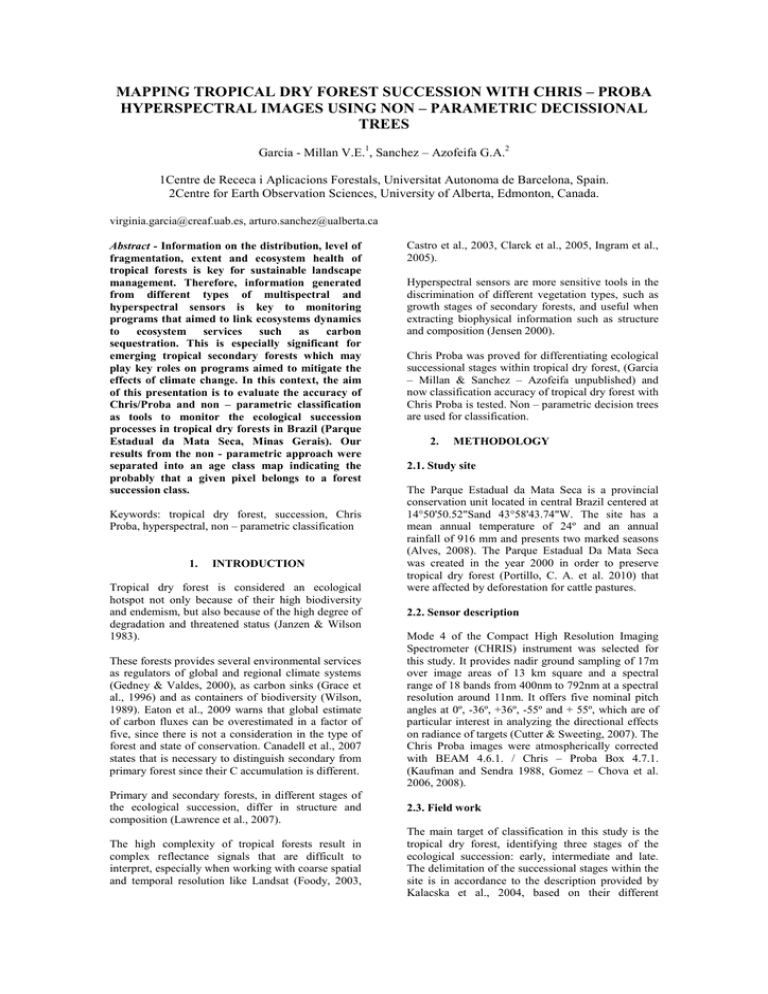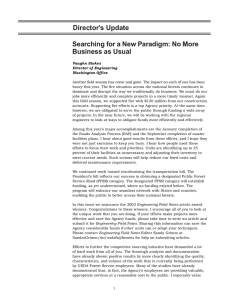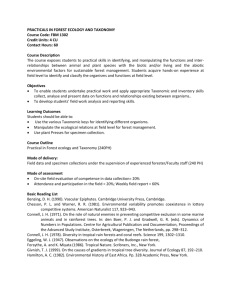MAPPING TROPICAL DRY FOREST SUCCESSION WITH CHRIS – PROBA
advertisement

MAPPING TROPICAL DRY FOREST SUCCESSION WITH CHRIS – PROBA HYPERSPECTRAL IMAGES USING NON – PARAMETRIC DECISSIONAL TREES Garcia - Millan V.E.1, Sanchez – Azofeifa G.A.2 1Centre de Receca i Aplicacions Forestals, Universitat Autonoma de Barcelona, Spain. 2Centre for Earth Observation Sciences, University of Alberta, Edmonton, Canada. virginia.garcia@creaf.uab.es, arturo.sanchez@ualberta.ca Abstract - Information on the distribution, level of fragmentation, extent and ecosystem health of tropical forests is key for sustainable landscape management. Therefore, information generated from different types of multispectral and hyperspectral sensors is key to monitoring programs that aimed to link ecosystems dynamics to ecosystem services such as carbon sequestration. This is especially significant for emerging tropical secondary forests which may play key roles on programs aimed to mitigate the effects of climate change. In this context, the aim of this presentation is to evaluate the accuracy of Chris/Proba and non – parametric classification as tools to monitor the ecological succession processes in tropical dry forests in Brazil (Parque Estadual da Mata Seca, Minas Gerais). Our results from the non - parametric approach were separated into an age class map indicating the probably that a given pixel belongs to a forest succession class. Keywords: tropical dry forest, succession, Chris Proba, hyperspectral, non – parametric classification 1. INTRODUCTION Tropical dry forest is considered an ecological hotspot not only because of their high biodiversity and endemism, but also because of the high degree of degradation and threatened status (Janzen & Wilson 1983). These forests provides several environmental services as regulators of global and regional climate systems (Gedney & Valdes, 2000), as carbon sinks (Grace et al., 1996) and as containers of biodiversity (Wilson, 1989). Eaton et al., 2009 warns that global estimate of carbon fluxes can be overestimated in a factor of five, since there is not a consideration in the type of forest and state of conservation. Canadell et al., 2007 states that is necessary to distinguish secondary from primary forest since their C accumulation is different. Castro et al., 2003, Clarck et al., 2005, Ingram et al., 2005). Hyperspectral sensors are more sensitive tools in the discrimination of different vegetation types, such as growth stages of secondary forests, and useful when extracting biophysical information such as structure and composition (Jensen 2000). Chris Proba was proved for differentiating ecological successional stages within tropical dry forest, (Garcia – Millan & Sanchez – Azofeifa unpublished) and now classification accuracy of tropical dry forest with Chris Proba is tested. Non – parametric decision trees are used for classification. 2. METHODOLOGY 2.1. Study site The Parque Estadual da Mata Seca is a provincial conservation unit located in central Brazil centered at 14°50'50.52"Sand 43°58'43.74"W. The site has a mean annual temperature of 24º and an annual rainfall of 916 mm and presents two marked seasons (Alves, 2008). The Parque Estadual Da Mata Seca was created in the year 2000 in order to preserve tropical dry forest (Portillo, C. A. et al. 2010) that were affected by deforestation for cattle pastures. 2.2. Sensor description Mode 4 of the Compact High Resolution Imaging Spectrometer (CHRIS) instrument was selected for this study. It provides nadir ground sampling of 17m over image areas of 13 km square and a spectral range of 18 bands from 400nm to 792nm at a spectral resolution around 11nm. It offers five nominal pitch angles at 0º, -36º, +36º, -55º and + 55º, which are of particular interest in analyzing the directional effects on radiance of targets (Cutter & Sweeting, 2007). The Chris Proba images were atmospherically corrected with BEAM 4.6.1. / Chris – Proba Box 4.7.1. (Kaufman and Sendra 1988, Gomez – Chova et al. 2006, 2008). Primary and secondary forests, in different stages of the ecological succession, differ in structure and composition (Lawrence et al., 2007). 2.3. Field work The high complexity of tropical forests result in complex reflectance signals that are difficult to interpret, especially when working with coarse spatial and temporal resolution like Landsat (Foody, 2003, The main target of classification in this study is the tropical dry forest, identifying three stages of the ecological succession: early, intermediate and late. The delimitation of the successional stages within the site is in accordance to the description provided by Kalacska et al., 2004, based on their different structure and composition. Structure is measured in terms of height, tree density and trunk diameter, while composition refers to species diversity. statistically compare matrices (Congalton, 1991), what allows the comparison between seasons and angles for our study. A field campaign was conducted on August 2010 where 180 ground control points were gathered. 2.4. Image classification Classification accuracies as shown in table 2 for the wet season are very weak. Angles -55º and 0º achieve the highest accuracy percentages in general terms, but never reach the 50% accuracy. In the other hand, -36º and +36º show the weakest results when classifying late and intermediate stages, while slightly improves the classification of early. An assessment of the error matrices (results not shown) reveals that there is a big misclassification between successional stages and the dry forest is usually confused for all angles of observation with riparian forest and “carrasco”, a dense and low shrubland formed by a small group of species. 2.4. Image classification Ten Chris Proba images were classified, corresponding to dry and wet season and five angles of observation, as listed in table 1. Dry Season Wet Season -55º 13 Sept. 2008 24 May 2010 -36º 04 August 2010 24 May 2010 0º 18 Sept. 2009 24 May 2010 +36º 04 August 2010 24 May 2010 +55º 14 October 2010 24 May 2010 Table 1. Chris Proba acquired images for Mataseca. A set of 56 ground control points per category were used to classify the images, using the 60% of them for training the classification and the 40% for the validation. All potential classes in the scene were trained: early, intermediate and late succession, “carrasco”, crops, riparian forests, bare soil, water masses and nodata. Classification was performed in NLCD module of Erdas 9.1., with the support of a decisional tree performed in See5.0. 3. RESULTS Since the aim of this study is the classification of the succession within the tropical dry forest, only partial results are assessed instead of showing overall classification accuracies. Classification accuracies are evaluated by total accuracies per category (table 2) and the partial kappa coefficients (table 3). The kappa coefficient expresses the proportionate reduction in error generated by a classification process compared with the error of a completely random classification, meaning that higher values of kappa indicate better classification. Kappa is also a powerful technique in its ability to provide information about a single matrix as well as to Observation angle -55º -36º 0º +36º Accuracy Producers Users Producers Users Producers Users Producers Late 75.00% 44.44% 25.00% 15.38% 56.25% 34.62% 56.25% Dry season Class Intermediate 43.75% 58.33% 43.75% 30.43% 43.75% 46.67% 56.25% As shown in table 2, good classification accuracies for the dry season in general terms. The early stage is the weakest classified of dry forest categories for this season, especially for angles +55º (5.91% accuracy in average) and -36º (12.92% average), while the best performance is reached by -55º (50%). Late and intermediate stages show good results for all angles, reaching accuracies around the 50% average. Best results are achieved by angles -55º and +55º (59.72% for the late and 56.25% for the intermediate, respectively) and the weakest results are observed for -36º (20.19% and 37.09% for the late and intermediate stages). An evaluation of the error matrices (results not shown), indicates that there is not important confusion with other categories of classification, although there is some confusion between stages. Early stage is usually confused with “carrasco” and late stage for all angles. Intermediate classifies sometimes as late and viceversa, especially in angle -36º. Kappa coefficients support the results observed in error matrices, meaning that the dry forest succession is being better classified in the dry season than in the wet season, despite the fact that kappa values are in general low, suggesting that decision trees are not highly improving the classification of the dry forest in Mataseca more than a non – supervised classification should. In the case of the dry season, angles -55º and 0º present the highest kappa values, while -36º and +55º are practically null. For the wet season, all values are very low. Early 50.00% 50.00% 13.33% 12.50% 12.50% 66.67% 43.75% Late 37.50% 50.00% 12.50% 10.00% 56.25% 27.27% 12.50% Wet season Class Intermediate 56.25% 30.00% 6.25% 25.00% 25.00% 57.14% 6.25% Early 25.00% 17.39% 43.75% 28.00% 15.38% 16.67% 43.75% Users 39.13% Producers 62.50% +55º Users 31.25% Table 2. Classification accuracy for the late, and five angles of observation. 4. 47.37% 62.50% 50.00% intermediate and DISCUSSION Observed results support the dry season as the best moment in the phenology cycle to discriminate succession in the tropical dry forest by remote sensing, as Kalascka et al. 2004, Castro et al. 2003 and Garcia – Millan et al. (unpublished) stated before. Although there is some confusion between 31.82% 10.00% 6.25% 31.25% 5.56% 27.78% early stages of succession for 25.00% 28.00% 37.50% 25.00% 28.57% 36.36% the dry and wet season stages within the dry forest for some angles, the more important achievement is that the dry forest is totally discriminated respect to other categories in the dry season. Classification of successional stages during the wet season may lead to confusion with other vegetation classes, like riparian forest or “carrasco”. This may respond to the fact that the tropical dry forest presents a homogeneous green canopy during Dry season Class Intermediate Wet season Class Intermediate Observation angle Late Early Late Early -55º 0.375 0.5313 0.4375 0.4333 0.2067 0.0638 -36º 0.042 0.2124 0.0174 0.1878 0.436 0.0558 0º 0.2638 0.3995 0.6247 0.1796 0.5166 0.082 +36º 0.2986 0.3935 0.2143 -0.0134 0.1555 0.1893 +55º 0.2193 0.4322 -0.0725 0.1838 0.1928 0.2809 Table 3. Partial Kappa coefficients for the successional stages of the tropical dry forest, for the dry and the wet season. the wet season and different successional stages are unable to be discriminated by a remote sensor. For the dry season, structure differences become more conspicuous like density of gaps in the canopy or tree height, that are different for each stage. In the case of nadir observation angles, we can observe the understory throw the canopy gaps in the early and intermediate stages, while observing a continuous dry canopy in the late stage. The reflectance of branches in the late stage is different to litter in the intermediate stage and bare soil and dry pasture in the early stage, helping in the discrimination of successional stages. Extreme observation angles have been observed to provide better results (-55º and +55º), revealing tree height as the most significant difference between successional stages. Tree height and understory features are not that evident in the wet season because light scattering of leaves may send a confusing reflectance signal to the remote sensor. Although good results in big traits for the dry season, early is sometimes confused with “carrasco” and intermediate and late are difficult to distinguish. This may respond to the fact that those categories present similar structure, especially for the spatial resolution provided for Chris Proba. Probably the most influencing structural parameter is height, which is slightly different between “carrasco” and early, and between intermediate and late, and as suggested before, may be playing an important role. The classification method is also playing an important role in the characterization of the tropical dry forest succession in terms of seasonality. Castro – Esau 2004 also compared parametric and nonparametric classifiers in tropical dry forest and found that nonparametric ones perform much better for classifying successional stages, as defined in this study. In her case, decisional trees obtained the weakest results of all nonparametric classifiers used and argued that they do not work well with features that have a large number of possible values (Mitchell, 1997). Nevertheless, her study was conducted during the wet season, when the high diversity of trees is reflected in their leaves. For the dry season, most of the leaves are gone and the variability of features is smaller between successional stages in terms of composition. This is another reason for the better results for the dry season, in comparison with the wet season. However, other nonparametric classifiers shall be tested in order to improve kappa values. 5. CONCLUSIONS This paper approves the quality of Chris Proba for the discrimination successional stages in tropical dry forests at a landscape level, providing a priceless tool for mapping the distribution and extent of secondary and primary forest, needed in the monitoring of carbon fluxes. It also points out the importance of the phenology when studying ecological processes within the forest, like succession, especially when working with remote sensing. In the particular case of Chris Proba, multi – angularity has been proved to play a special role in the interpretation of light scattering and bidirectional reflectance distribution of vegetation targets. Further research is needed to improve classification accuracy in the field of nonparametric classifiers. REFERENCES Alves, R. Zonamento ambiental e os desafios da implementação do Parque Estadual Mata Seca, Municipio de Manga, Norte de Minas Gerais. Instituto de geociencias da Universidade Federal de Minas Gerais. Belo Horizonte, Brasil. 2008. Canadell, J.G., Le Quere, C., Raupach, M.R. Contributions to accelerating atmospheric CO2 growth from economic activity, carbon intensity and efficiency of natural sinks. Proceedings of the National Academy of Sciences of the United States of America. Vol. 104, Issue 47. 2007. Castro, K. L., Sanchez – Azofeifa, G. A. & Rivard, B. Monitoring secondary tropical forests using space – borne data: implications for Central America. International Journal of Remote Sensing. Vol. 24, nº 9, 183 – 1894p. 2003. Castro – Esau, K. L., Sanchez – Azofeifa, G. A., Rivard, B., Wright, S. J., Quesada, M. Variability in leaf optical properties of Mesoamerican trees and the potential for species classification. American Journal of Botany 93 (4): 517 -530. 2006. Clark, M. L., Roberts, D. A., Clark, D. B. Hyperspectral discrimination of tropical rain forest tree species at leaf to crown scales. Remote sensing of Environment 96 (2005) 375 – 398. Congalton, R. A Review of Assessing the Accuracy of Classifications of Remotely Sensed Data. Remote Sensing of Environment 37: 35-46. 1991. Cutter, M. & Sweeting, M. A hyperspectral imaging mission for small satellites – five years orbit experience. I – 4244 – 1057 – 6/07. IEEE. 2007 Eaton, J. M. & Lawrence, D. Loss of carbon sequestration potential after several decades of shifting cultivation in the Southern Yucatan. Forest Ecology and Management. Vol. 258, Issue 6, 949 – 958p. 2009. Foody, G. M. Remote sensing of tropical forest environments: towards the monitoring of environmental resources for sustainable development. International Journal of Remote Sensing. Vol. 24, nº 20, 4035 – 4046p. 2003. Gedney, N. & Valdes, P.J. 2000. the effect of Amazonian deforestation on the northern hemisphere circulation and climate. Geophysical Research Letters, Vol. 27, Issue 19. Gomez-Chova, L., Camps-Valls, G., Amoros-Lopez, J., Calpe, J., Guanter, L., Alonso, L., Fortes, J.C., Moreno, J. Cloud Probability mask for Proba / Chris Hyperspectral images. 2006 Gómez-Chova L., Alonso L., Guanter L., CampsValls G., Calpe J. and Moreno J. Correction of systematic spatial noise in push-broom hyperspectral sensors: application to CHRIS/PROBA images. 2008. Grace, J., Malhi, Y. Lloyd, J. The use of eddy covariance to infer the net carbon dioxide uptake of Brazilian rain forest. Global change biology, Vol.2, issue 3, 209 – 217p. 1996. Ingram, J. C., Dawson, T. P., Whittaker, R. J. Mapping tropical forest structure in southern Madagascar using remote sensing and artificial neural networks. Remote Sensing of Environment 94 (2005) 491 – 507. Kalacska M., Sánchez-Azofeifa G.A., Rivard B., Calvo-Alvarado J.C., Journet A.R.P., Arroyo-Mora J.P., Ortiz-Ortiz D. Leaf area index measurements in a tropical moist forest: A case study from Costa Rica. 2004. Remote Sensing of Environment 91 (2004) 134–152. Kaufman Y. J. and Sendra C., “Algorithm for atmospheric corrections” International Journal of Remote Sensing, vol. 9, pp. 1357–1381, 1988. Janzen, D. H. & Wilson, D. E. Mammals. P426 -442. Costa Rican Natural History. Chicago University Press, Chicago, USA. 1983. Jensen, G. L. Peterson,J. Q., Greenman, M. Measurement results from flight measurements with the hyperspectral imaging polarimeter. Conference on Polarization Analysis, Measurement and Remote Sensing III. Vol. 4133, 214 – 220p. 2000. Lawrence, D., D’Odorico, P., Diekmann, L. Ecological feedbacks following deforestationcreate the potential for a catastrophic ecosystem shift in tropical dry forest. Proceedings of the National Academy of Sciences of the United States of America. Vol. 104, Issue 52. 2007. Mitchell, T. M. Machine learning. New York: McGraw-Hill. 1997. Portillo - Quintero, C. A., Sánchez – Azofeifa, G. A. Extent and conservation of tropical dry forests in the Americas. Biological Conservation 143 (2010)144155. 2010. Wilson, E.O. Threats to biodiversity. Scientific American, Vol. 261, Issue 3, 108p. 1989.


